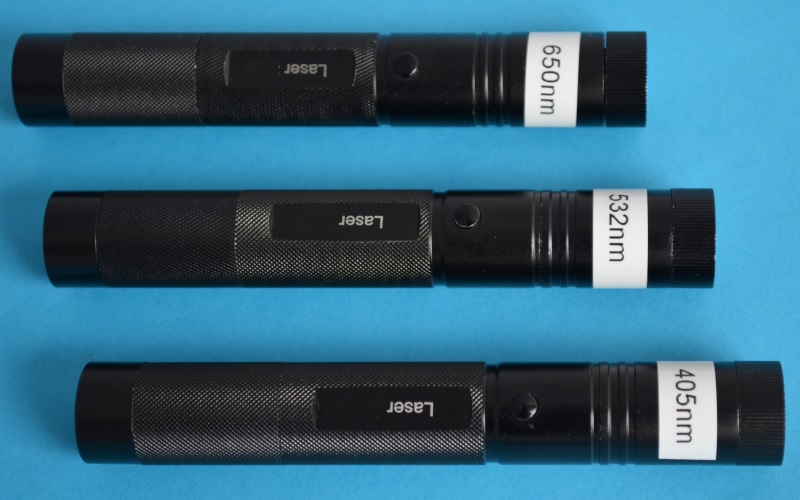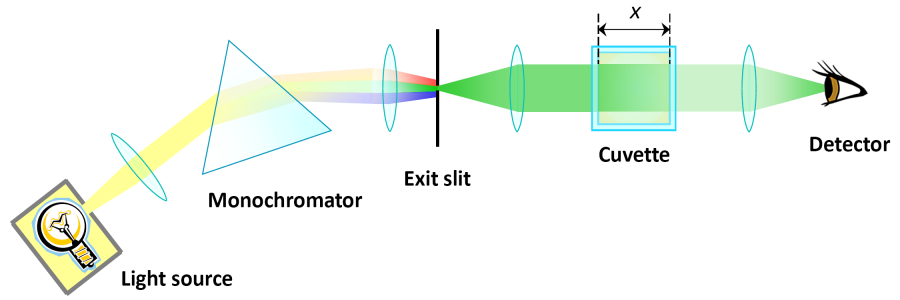Conseils supplémentaires pour la fiche de travail 4.1 :
Comment construire soi-même un photomètre d'absorption (1/4)
Questions:
- Comment peut-on améliorer la présentation d'un photomètre en plus des informations de la fiche de travail 4.1 ?
- Quelles sont les erreurs de mesure susceptibles de se produire et comment les réduire ou les éviter ?
La source lumineuse
- Le spectre d'un coefficient d'absorption doit être déterminé sur une large gamme spectrale.
Une source lumineuse à large bande est nécessaire. Sa lumière sera séparée en ses parties spectrales par un monochromateur. Les lampes halogènes sont les sources de lumière préférées grâce à leur luminance dans les plages de 500 à 3000 nm. Leur luminosité est stable si elles sont utilisées avec une alimentation stabilisée en courant continu. Le fonctionnement en courant alternatif (avec un transformateur) ou avec un adaptateur de prise non stabilisé est défavorable : fonctionnant à 50 Hz, les lampes halogènes scintillent à 100 Hz, car le filament est chauffé et refroidi à chaque demi-onde, et l'émission dépend de la température du filament. Cela peut dégrader la qualité des données mesurées.
La luminosité des lampes halogènes est faible dans le bleu et inexistante dans l'ultraviolet. C'est pour cette raison que les photomètres des laboratoires utilisent des lampes au deutérium en plus des lampes halogènes. Les lampes au deutérium émettent de la lumière à des longueurs d'onde courtes de 200 à 450 nm, mais elles sont relativement chères et nécessitent une alimentation électrique spéciale. Leur rayonnement UV est dangereux pour l'œil et la peau.
Une autre solution consiste à limiter les essais à un plus petit nombre de longueurs d'onde. Dans ce cas, les pointeurs LED ou laser sont pratiques car ils peuvent être facilement échangés dans l'installation optique. Cela doit être possible de manière reproductible afin d'éviter les erreurs de mesure occasionnelles dues à un alignement imprécis. Un monochromateur n'est plus nécessaire. Leur luminosité est stable, bien qu'elle dépende de la température. La largeur de bande spectrale des LED se situe entre 10 nm dans l'infrarouge et le rouge et environ 50 nm dans le bleu. Cela peut conduire à des erreurs de mesure systématiques avec des substances ayant une caractéristique d'absorption très variable dans la bande passante d'une LED.
Les LED blanches sont en fait des LED émettant dans le bleu : une partie de leur lumière bleue est convertie par un phosphore en une large bande d'émission aux longueurs d'onde vertes, jaunes et rouges, ce qui donne l'impression de blanc. Avec une LED émettant de la lumière blanche, il faut utiliser un monochromateur.
Les pointeurs laser (contrairement aux LED) sont très lumineux et ont une très petite largeur de bande spectrale. Leur rayonnement est bien parallélisé par une lentille intégrée. Cela présente un grand avantage, car la lentille située devant la cuvette et le monochromateur ne sont pas nécessaires.


